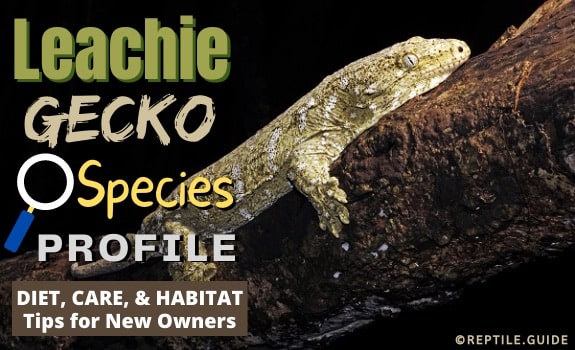The Leachianus Gecko or “Leachie Gecko” (Rhacodactylus Leachianus) is a unique species of gecko that has captivated reptile lovers and keepers alike due to its large size (opens in new tab).
A popular species of gecko amongst beginner and experienced reptile owners alike, Leachie Geckos are desirable for not only their size but unique vocalizations as well.
However, these geckos can be fussy eaters and have a tendency to act aggressive due to their highly territorial instincts, making them not an ideal pet for all.
Regardless of whether you’re considering adopting a Leachie Gecko or have recently brought one home, this guide will help walk you through everything you need to know!
In This Article
What is a Leachie Gecko?
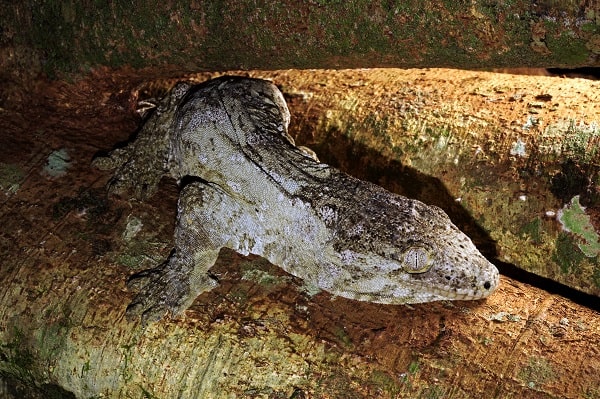
Before diving deep into care, let’s take a brief moment to first discuss background information on the Leachie Gecko…
A Leachie Gecko is a species of gecko that is native to island in the South Pacific referred to as New Caledonia. They measure on average between 7 and 18 inches long on average.
There are 2 subspecies of Leachie Gecko, the Rhacodactylus Leachianus (R.L. Leachianus) and the Rhacodactylus Leachianus Henkeli, with the former being found on Grande Terre and the latter Pine Island.
Between the 2 subspecies, the primary differences are in size and color. The R.L. Leachianus is most notable for its large size, whereas the Henkeli is the more colorful reptile.
The largest known species of gecko, “Leachies” as they are often referred to, come in various shades of brown, green, grey, and tan. These neutral and natural colors help them blend into the trees where, as an arboreal species, they spend most of their time.
Because Leachies live up high in the hollows of trees, they need to resemble tree bark in not only color, but texture as well in order to properly camouflage.
Fortunately, their bumpy looking skin and and thick, stumpy tails help to accomplish this.
One of the reasons Leachies are so desirable is because of their unique vocalizations. Leachies yip, growl, chirp, and squawk as part of their natural defense mechanisms.
⭐️ Fun Fact: Did you know? The Leachie Gecko goes by several different names, including Giant Gecko, New Caledonian Gecko, and Leach’s Giant Gecko.
Leachie Gecko Lifespan
With proper care, healthy Leachie Geckos can be expected to live 20 years. However, it is not unheard of for them to live beyond this as well.
With the potential to live for decades, a Leachie Gecko will NOT make an ideal choice for just anyone. All prospective new owners should be prepared to provide care for the longterm.
| Facts at a Glance: | |
|---|---|
| Common name | Leachie Gecko, Leachianus Gecko, Giant Gecko, New Caledonian Gecko |
| Scientific name | Rhacodactylus Leachianus & Rhacodactylus Leachianus Henkeli |
| Adult size | 7-18 inches |
| Price | $600 to $1,000+ |
| Lifespan | 20 years |
| Diet | Insects, Fruit, Mice |
| Tank Size | 18” L x 18” W x 24” H (40 gallons) |
| Temperature & Humidity | 75 Degrees Fahrenheit Ambient Temperature & 50-60% Humidity |
| Popular alternatives | Leopard Gecko, Mexican Alligator Lizard |
Leachie Gecko Care Guide
A Leachie Gecko makes a wonderful pet for those who have owned or are familiar with the care requirements of Crested Geckos.
Like Crested Geckos, they require daily care, which at a minimum, will mean spraying their enclosure just enough for droplets of water to accumulate for drinking purposes.
Keep reading to discover everything you need to know about how to properly care for a Leachie!
Leachie Gecko Food and Diet
In their natural habitat, Leachie Geckos consumer a variety of insects such as roaches and crickets, as well as fruit and other small lizards. By nature they are omnivores.
Ideally, you would recreate their natural diet in captivity by offering them gut-loaded protein feeders and some fruit.
However, Similar to that of handling, they can also be very finicky in terms accepting insects. Some will gobble up feeders happily while others will turn their little snouts up and outright ignore them altogether.
Fortunately, one pro of owning a Leachie is that they can eat the same diet as that of a Crested Gecko, which is readily available for purchase through just about any pet supply retailer.
This diet consists of a dry powder that you mix with water. It’s easy to store and virtually mess-free.
A Leachie Gecko’s diet will delight those who are squeamish and grossed out by bugs or hate the thought of having to store them somewhere in their home. Very few insects are required weekly to keep your Leachie healthy. And in some instances, your Leachie may even refuse bugs and prefer a commercial diet.
However, it is still best to try and still feed your adult Leachie Gecko live protein about 2 times a week, with hatchlings and juveniles needing to be fed 4 times per week.
Each feeding can consist of a mere 2 crickets or roaches. However, once your Leachie reaches a year of age, you can consider feeding them a small mice as well.
🤓 Expert Tip: As with all reptiles, the Leachie Gecko can suffer from impaction, which is essentially a blockage in the digestive system. One way to avoid this is to feed them insects no bigger than the spaces between their eyes.
With every meal you offer live protein, be sure to dust feeders in Calcium lightly. However, you’ll want to skip calcium once a week for adults and twice a week for babies ands hatchlings as you dust with a multi-vitamin instead.
NEVER dust food with both calcium and a multivitamin supplement as they should be given on different days.
In terms of fresh fruits, your Leachie can safely eat…
- Apples
- Apricots
- Banana
- Blackberries
- Blueberries
- Cantaloupe
- Dates
- Grapes
- Figs
- Mango
- Peaches
- Pears
- Plums
- Raspberries
- Strawberries
- Watermelon
Fruit should be provided every other day.
🤓 Expert Tip: Since Leachie Geckos spend so much time in trees, they may be hesitant to eating food that is placed on the floor of their enclosure. Try placing fruit in a bowl up high or on branches to appease their natural instincts.
Leachie Gecko Enclosure
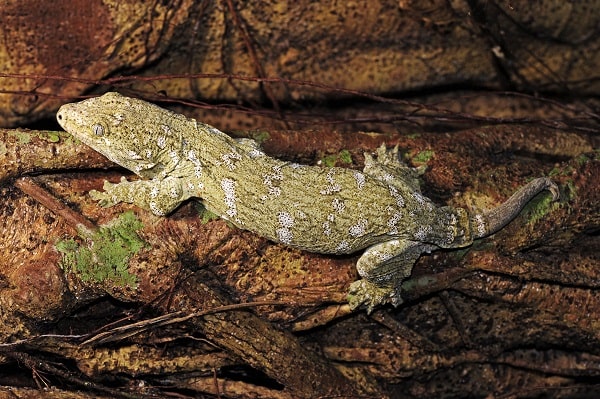
As with all reptiles, a proper enclosure will help ensure your pet not only lives out a long and healthy life, but a happy one as well!
To ensure your Leachie Gecko thrives, be sure to pay special attention to the tank and enclosure specifications below…
Leachie Gecko Tank Size
When it comes to tank and enclosure size, you’ll most likely be pleased to know that Leachie Geckos do not require massive enclosures, which means you can expect to spend less on the initial setup than you would with larger lizards.
However, it is important to note that Leachie Geckos will significantly benefit from vertical enclosures that allow them to climb. Since they are arboreal, height is important.
Ideally, your adult Leachie Gecko will live in a tank that is around 40 gallons. But not just any old 40 gallon tank will do! Try to aim for a tank that measures at least 18 inches wide by 18 inches deep by 24 inches tall.
For hatchling Leachie Geckos, 10 gallon tanks work just fine while juvenile Leachies (those between 2 and 12 months) will thrive in a 20 gallon tank.
Glass enclosures with frontward opening doors and mesh tops are preferred.
If your tank doesn’t come with a built-in background, you should absolutely consider including one!
Cork tile backgrounds can be cut to fit your enclosure and create a wonderful nature texture. You can also buy realistic foam background enclosure inserts online too.
Leachie Gecko Lighting and Temperatures
Unlike other reptiles, Leachie Geckos don’t require additional lighting of any sort since they’re nocturnal.
However, your enclosure will benefit from UVB if you decide to include live plants. Additionally, UVB may help regulate your Leachie’s sleeping schedule but again, it isn’t a requirement to include.
In terms of their circadian rhythm, Leachies are nocturnal so you’ll want to ensure lights are kept off at night when they are active.
However, as with all reptiles, Leachie Geckos thermoregulate their internal body temperature through external means. Basically? You need to maintain/provide heat sources.
When it comes to temperature requirements, try to keep their tank’s ambient temperature around 75 degrees Fahrenheit. However, you can create hot spots that reach as high as the low 80s.
At night, you’ll want to ensure the tank’s overall temperature does not slip below 65 degrees Fahrenheit. In the event that it does, consider purchasing a ceramic heat emitter or under tank heater.
Leachie Gecko Humidity
Leachie Geckos will do best in a tank with humidity around 60%.
As aforementioned, you should be prepared to mist their tank twice daily to provide droplets of water for drinking. This can also help keep humidity levels up.
A water bowl can also be provided but be sure to opt for one with a heavy bottom that cannot be tipped.
Although daily misting is a must, you won’t want to overly-saturate their enclosure so that humidity levels become too high. Ideally, you’ll just spray until you see droplets form and then stop. This should be practiced in the morning and at night, with the cage being fully dry between mistings.
Leachie Gecko Substrate
When it comes to substrate, you’ll have several options to choose from.
If you want to incorporate live plants, then opting for potting soil will be ideal. However, artificial plants work just as well so don’t think live plants are your only option.
If you don’t intend on incorporating live plants, any of the following work great for substrate…
- Coconut fiber
- High-grade mulch
- Organic soil mixture (peat moss, cypress mulch, etc.)
At the end of the day, you should always prioritize substrates that will hold humidity well.
However, it should be noted that Leachies can be prone to getting fungal infections on their toe pads, which more times than not, results from too much moisture in their enclosure.
As such, you’ll want to make sure their substrate isn’t soggy or too wet and can in fact, air out periodically.
🤓 Expert Tip: Although bioactive enclosures are by far the most naturalistic and appealing to reptiles, they do NOT make a good choice for a Leachie Gecko. Because Leachie’s produce large waste (in quantity and size) it would be virtually impossible to keep the enclosure clean without having to remove waste yourself, which defeats the purpose of a self-cleaning bioactive setup.
Leachie Gecko Handling
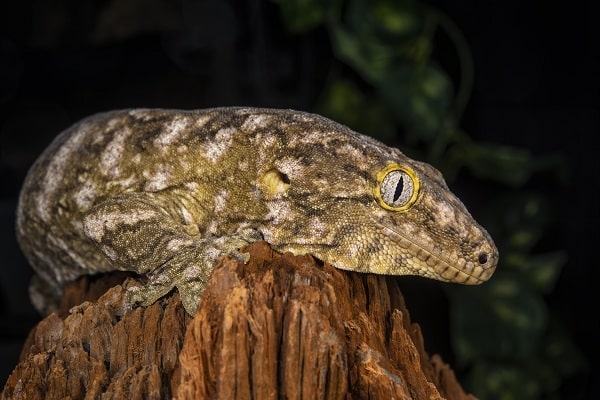
Although some leachies can be very easy to handle and quite calm, others can be a nightmare and refuse to be held!
In severe instances, some may even bite their handlers to avoid being handled. When adopting a Leachie, it really can be a crapshoot in terms of getting one that will enjoy being handled.
Some may even lose their tail under extreme stress, although this is quite rare as opposed to Leopard Geckos which drop their tail frequently.
Leachie Geckos can be a good choice for those who are new to lizards because they have a larger, stockier body type compared to other, more fragile lizards.
However, if you adopt a Leachie Gecko that prefers not to be handled, then hardiness will be a non-factor.
If you are looking for more of a challenge, and are experienced already, see if the Giant Day Gecko is for you!
Leachie Gecko Temperament
One of the biggest cons of Leachie Geckos is that they are antisocial lizards by nature. Because of this, it is entirely possible for owners to adopt a Leachie that never warms up to them or learns to enjoy handling.
However, Leachies that are handled from a young age, tend to warm up to their owners and tolerate being handled quicker.
Leachies below 2 months of age should not be handled, nor should new Leachies who haven’t yet acclimated to a new home. Once you have your new Leachie for at least 2 weeks you can consider handling them if they are eating regularly. A healthy appetite is a good indication that your pet is not stressed.
Seeing as they prefer to be observed and spend most of their time hiding, first-time reptile owners who desire a relationship with their pet would do best to consider a different reptile that is easy to handle.
Are Leachie Geckos Aggressive?
The primary reason Leachie Geckos can be so aggressive is because they are highly territorial.
In fact, it is not uncommon for Leachies to showcase what is referred to as “Cage Aggression” in which they growl at those encroaching on their space. In some instances they may even lunge or bite hands moving towards them!
However, as aforementioned, your Leachie stands the BEST chance of being socialized if handled from a young age (more on this below).
Leachie Gecko Bite
Naturally, you may find yourself wondering about a Leachie Gecko bite. More specifically, how bad it hurts, why it happens, and how to avoid being bitten are the topics you’re probably most interested in.
To be quite honest, Leachie Gecko bites can hurt as their jaws are quite strong.
To avoid being bitten, it is advisable to wear thick gloves (pruning or leather work well) when handling an aggressive Leachie. Frequent handling of a new Leachie is also advisable, however, be sure to let any new pet settle in for a few weeks before attempting to handle them.
After an initial 2 week adjustment period, New Leachies should be handled daily for at minimum 10 minutes for up to 3 weeks to acclimate them to new owners.
⭐️ Fun Fact: Some Leachies have been known to be all bark and no bite, as evidenced by the bluff-charging, hissing, and head butting behavior they resort to instead of biting. This is most commonly witnessed in cage-aggressive new Leachies who haven’t yet acclimated to their human caretaker.
Leachie Gecko Sale Price
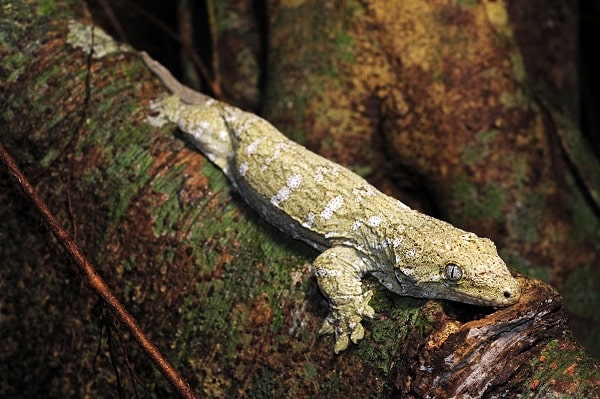
To put it simply, Leachie Geckos can be quite expensive. Purchasing the Leachie Gecko can set you back anywhere from $600 to $1,000 USD!
However, it isn’t uncommon to see rarer morphs fetch several thousand dollars.
Why Are Leachies So Expensive?
Unlike more popular gecko counterparts, Leachie Geckos are much more expensive for essentially two reasons.
First and foremost, Leachie Geckos are notoriously difficult to breed.
You see, Leachie Geckos will not be willing to breed with just any other Leachie Gecko of the opposite sex. Instead, it is imperative that breeders find compatible pairs. If two Leachie geckos aren’t compatible they may fight and become violent with one another!
Their highly selective nature when it comes to breeding partners is partly due to their unique ability to establish deeper social ties than many other reptiles as they are believed to form, at the very least, temporary bonds amongst themselves.
Furthermore, when Leachie Geckos are successfully bred, females tend to lay less eggs than other lizard species.
More specifically, you can expect a gravid (pregnant) female Leachie Gecko to lay anywhere from 1 to 6 clutches with 2 eggs per clutch.
However, 2-3 clutches will be the relative norm in a single breeding season.
By breeding season’s end, this culminates in significantly less eggs than that of other lizards and gecko species.
To give you an example, it isn’t unheard of for an experience breeder to see their female Leopard Gecko lay 10 or more clutches in a single season. On the flip side, this same experienced breeder would have a very difficult time getting their Leachie Gecko to lay even 6 clutches.
If you’re new to breeding reptiles, a “clutch” is the term used to refer to the group of eggs laid at one particular time by a reptile during her pregnancy. Most reptiles are capable of producing several clutches from a single pregnancy.
The second reason Leachie Geckos are so expensive is because they are extremely popular and desirable.
Ironically enough, their overall rarity helps makes them more desirable to reptile keepers and as such, ensures that available Leachie Geckos tend to be snatched up rather quickly, only making them more rare and expensive in the long run.
To put it in laymen’s terms, the supply of Leachie Geckos simply does not meet the demand.
This can be both a pro and con for those interested in breeding Leachie Geckos as it ensures they will produce a desirable commodity to sell BUT may struggle to initially find a successful breeding pair.
Are Leachie Geckos Good Pets? A Summary.
Although a real treat for many reptile owners due to their rarity and unique look, Leachie Geckos are not exactly ideal choices for first time reptile owners.
Between their expensive upfront cost, lack of availability, and potential refusal to be handled, they can be trying pets.
However, for those who have the budget, are willing to do the proper research, and are perfectly fine without regularly handing their pet, the Leachie makes a wonderful pet that is a joy to observe!
In fact, you’d be hard pressed to find a cooler reptile. But if you want to try, we also love the Tokay Gecko!
Alternatively, crocodile geckos are also great display animals, even for beginner-intermediate reptile keepers.
